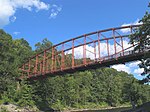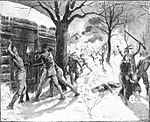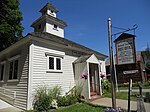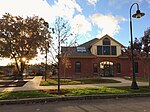The Raid on Deerfield, also known as the Deerfield Massacre, occurred during Queen Anne's War on February 29, 1704, when French and Native American raiders under the command of Jean-Baptiste Hertel de Rouville attacked the English colonial settlement of Deerfield, Massachusetts, just before dawn. They burned parts of the town and killed 47 colonists. The raiders left with 112 colonists as captives, whom they took overland the nearly 300 miles to Montreal; some died or were killed along the way because they were unable keep up. Roughly 60 colonists were later ransomed by their associates, while others were adopted by Mohawk families at Kahnawake and became assimilated into the tribe. In this period, English colonists and their Indian allies were involved in similar raids against French villages along the northern area between the spheres of influence.
Typical of the small-scale frontier conflict in Queen Anne's War, the French-Indian forces consisted of French soldiers and about 240 Indian warriors, mostly Abenaki (from what is now Maine), but including Huron (Wyandot) from Lorette, Mohawk from Kahnawake (both mission villages), and a number of Pocomtuc who had once lived in the Deerfield area. Given the diversity of personnel, motivations, and material objectives, the raiders did not achieve full surprise when they entered the palisaded village. The defenders of some fortified houses in the village successfully held off the raiders until arriving reinforcements prompted their retreat. However, the raid was a clear victory for the French coalition that aimed to take captives and unsettle English colonial frontier society. More than 100 captives were taken, and about 40 percent of the village houses were destroyed.
Although predicted because of existing tensions during the war, the raid shocked colonists throughout New England. Conflict increased with the French and French-allied Indians. Frontier settlements took actions to fortify their towns and prepare for war. The raid has been immortalized as a part of the early American frontier story, principally due to the published account by a prominent captive, the Rev. John Williams, who was the principal leader of the village. He and much of his family were taken on the long overland journey to Canada. His seven-year-old daughter Eunice was adopted by a Mohawk family; she became assimilated, married a Mohawk man, and had a family with him. Williams's account, The Redeemed Captive, was published in 1707 soon after his release, and was widely popular in the colonies. It became part of the genre known as captivity narratives.








